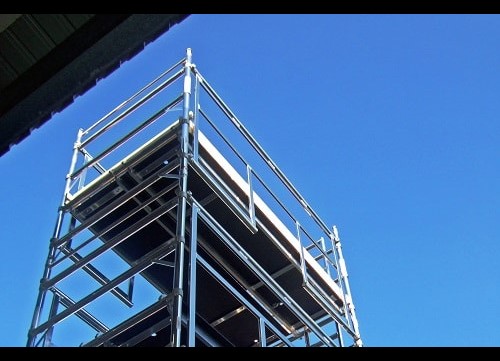Aluminium scaffold towers can provide safe access to awkward high areas, but it’s essential they are only designed, assembled and dismantled by qualified personnel.
Features
Heading for the top
There’s a whole range of standard scaffold towers available to buy or hire – from straight up and down single bay structures to more advanced structures like towers with bridges or cantilevers.
But what if none of them suit your requirements? Well, aluminium towers are more adaptable than you might think. If needed, you can get a bespoke structure for your site, however tall, wide or awkward it may be. It will be designed, assembled and dismantled for you by a company offering ‘hire and assembly’ services, providing your team with a safe place to work at height.
Why pick aluminium towers?
Aluminium towers have many advantages:
- Quick to build and dismantle – suiting tight timescales
- Lightweight – essential when the floor/ground can’t hold steel or powered access
- Low carbon footprint – travels in a transit van, not a 10-tonne truck
- Aesthetically pleasing – looks good in high-profile locations
- Flexible – gets into awkward spaces
- Collective fall prevention at all times – no harnesses required
- Competitively priced.
 Bespoke aluminium scaffold towers can be used to allow people to work safely at height in awkward to reach and very high areas. Photo: PASMA
Bespoke aluminium scaffold towers can be used to allow people to work safely at height in awkward to reach and very high areas. Photo: PASMA
Bespoke towers can go wide, high and around obstacles. They can reach the top of a building, with platforms at every level along the way, and span the whole façade too. They can go over doorways, bridge swimming pools, have large deck areas or squeeze into tight spaces like lift shafts.
They can be mobile or tied in, adapted to meet evolving requirements or remain in place for longer periods. In short, access towers are very flexible.
But building such complex structures with lightweight, prefabricated aluminium components requires specialist skills, so it’s important to choose a competent supplier. How do you find one you can trust?
Choosing a safe hire and assembly supplier
PASMA is a not-for-profit body whose members come from across the tower industry. Those who erect towers as a service are known as Hire and Assembly Members.
PASMA audits their working practices annually, giving you confidence that they do things properly. For example, they must:
- Use safe equipment, so every structure meets the relevant standard
- Collaborate with manufacturers to prepare assembly, use and dismantling plans for non-standard builds
- Have a competent workforce, including Access Tower Specialists trained by PASMA.
Only commission non-standard towers from PASMA Hire and Assembly Members – it’s your shortcut to finding a reputable provider. They can also assemble standard towers for you too. There’s a list of members online at: www.pasma.co.uk/hire-and-assembly
Access to sites
Before someone assembles a non-standard tower, ask to see their PASMA card. It should be different from a normal card: look for ‘Access Tower Specialist’ along the top.
This tells you they’ve completed an extensive theoretical and practical training programme and have an in-depth understanding of relevant product standards and legislation/regulations, as well as technical knowledge of:
- Design constraints
- Loading criteria
- Using enabling components
- Safe component lifting
- Tying in methods
- Understanding design drawings
- Hazard identification
- Safe assembly and dismantling techniques.
Access Tower Specialists are qualified to build any type of tower, standard and non-standard. But while any worker can be trained to build a standard tower, non-standard towers can only be planned and assembled by a qualified Access Tower Specialist.
Construction sites
PASMA is part of the Construction Skills Certification Scheme (CSCS) Partner Card Scheme, so Access Tower Specialist cards feature the CSCS logo. This provides a familiar and reliable way for construction managers to verify qualifications and training.
By following this guidance, you’ll ensure your tower is supplied and built by an appropriately skilled and qualified workforce and most importantly, that your team gets the safe space they need to work at height.
Design standards for towers
- BS EN 1004-1 covers freestanding, single bay mobile towers on wheels, with a platform height up to 8 metres outdoors and 12 metres platform height indoors
- BS 1139-6 covers any other tower, including tied towers (not freestanding), towers on base plates, cantilever towers, linked towers (with more than one bay), towers on stairs, towers with bridges, high level towers and large deck structures.
BS 1139-6 towers fall into two categories:
- Standard configurations: not site-specific; these come with user instructions from the manufacturer or supplier
- Non-standard configurations: bespoke; these must have a site-specific assembly, use and dismantling plan.
Competence
Anyone can learn to safely assemble BS EN 1004-1 towers and standard BS 1139-6 structures, by completing the relevant PASMA training courses.
However, non-standard towers should only be assembled by Access Tower Specialists.
For more information see: www.pasma.co.uk
Don Aers is technical director at PASMA.
FEATURES

Sedentary working and how to combat the ‘sitting disease’
By Gavin Bradley, Active Working on 05 April 2024
Prolonged and excessive sitting poses a major risk to our health, but the Get Britain Standing campaign and On Your Feet Britain Day on 25 April are a great way of encouraging workers to sit less and move more.

Company culture and wellbeing: a crucial link
By Bex Moorhouse, Invigorate Spaces on 05 April 2024
Investing in measures to support worker wellbeing will be ineffective unless the company culture genuinely incorporates values like teamwork, involvement, flexibility and innovation.

Office design and culture: happier and healthier staff – or the opposite?
By Guy Osmond, Osmond Ergonomics on 03 April 2024
Applying ergonomic principles to workstation set-ups and ensuring the physical environment supports neurodivergent people are just some of the ways of creating an office where everyone can thrive, but a supportive and positive organisational culture is vital too.


